The 2024 Guide to Insulation in the UK
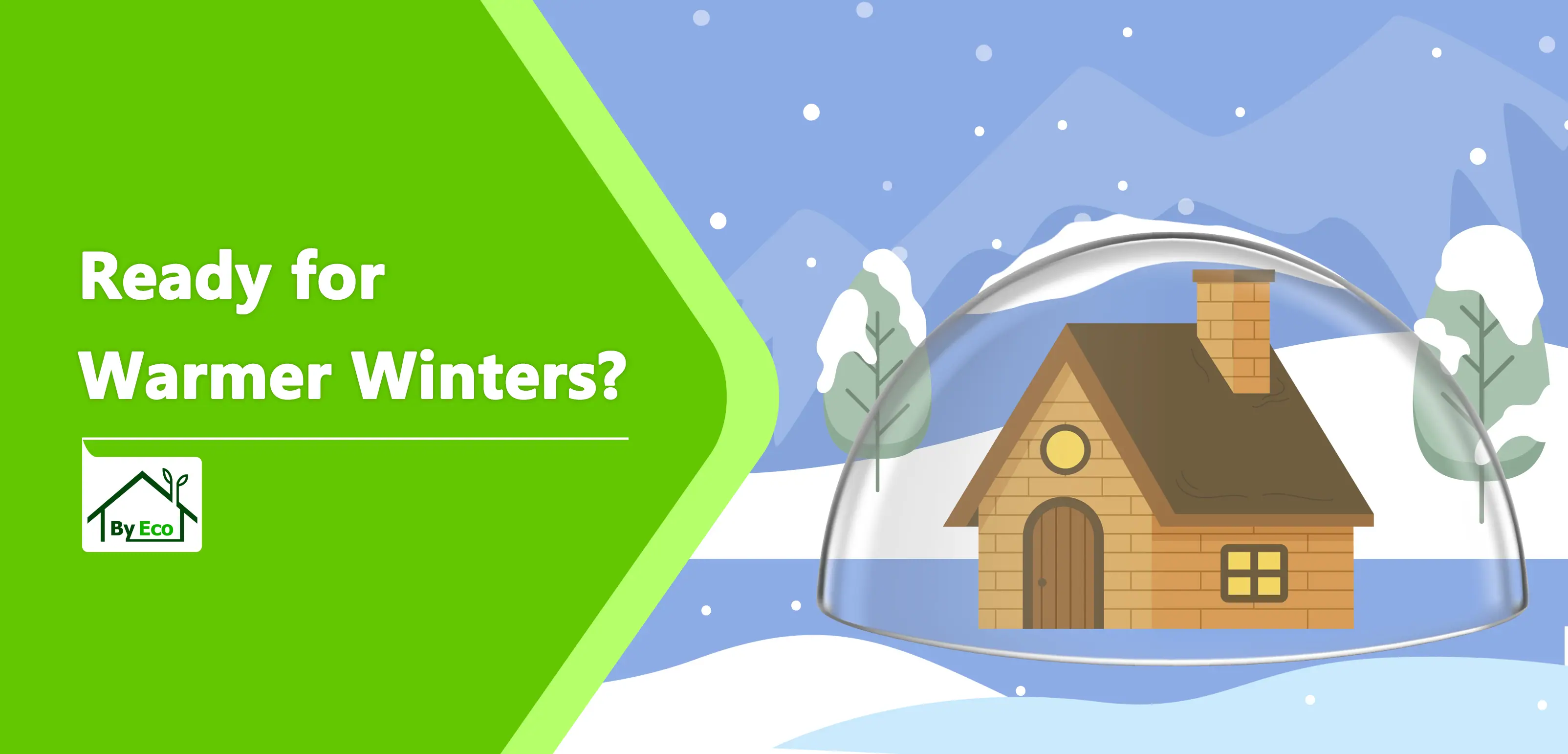
Welcome to ByEco’s comprehensive guide to home insulation in 2024, tailored for UK homeowners and tenants. Through our partnership with the government and utilising schemes like the ECO4 Scheme, ByEco provides a wide range of insulation services at no cost for eligible homes. Our mission is to empower you to make environmentally friendly choices for a greener planet in the future.
Why Insulate Your Home?
Insulation is key to maintaining comfortable temperatures year-round, reducing energy bills, and minimising your carbon footprint. Whether it’s keeping your home cosy in winter or cool during summer, the right insulation does more than just adjust the temperature—it embodies a step towards eco-friendly living.

Prevent heat loss by insulating your house
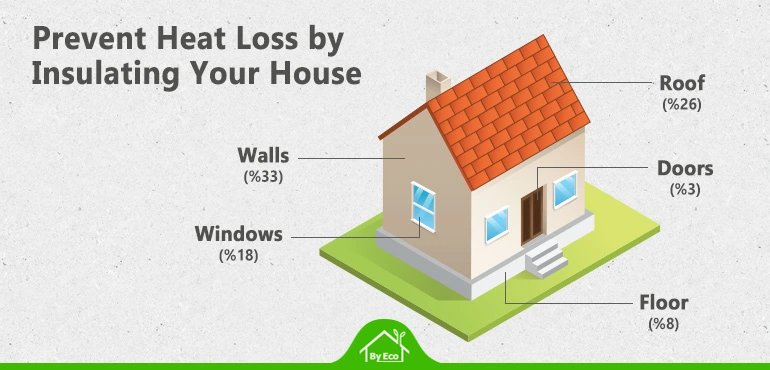
Preventing heat loss in your home is crucial for reducing energy bills, enhancing comfort, and contributing to a more sustainable environment. Proper insulation, such as loft insulation, cavity wall insulation, and roof insulation, plays a vital role in maintaining warmth during colder months by preventing heat from escaping through walls, roofs, and other vulnerable areas. Advanced solutions like expanding foam can also be applied to seal gaps and cracks, ensuring your home is as energy-efficient as possible. By upgrading your insulation, you not only improve your property's energy efficiency but also take a significant step towards lowering your carbon footprint. Our government-approved grants make it easier than ever to apply for these essential home improvements, ensuring your house remains cosy and eco-friendly throughout the year.
Types of Insulation and Their Benefits
There are several methods to achieve optimal insulation, each type offers specific benefits, addressing different areas of your home from walls to attics. Selecting the right insulation is key to improving your home's energy efficiency and comfort.
This section details the advantages of various insulation methods, guiding you towards making an informed choice for a more sustainable and comfortable living environment.
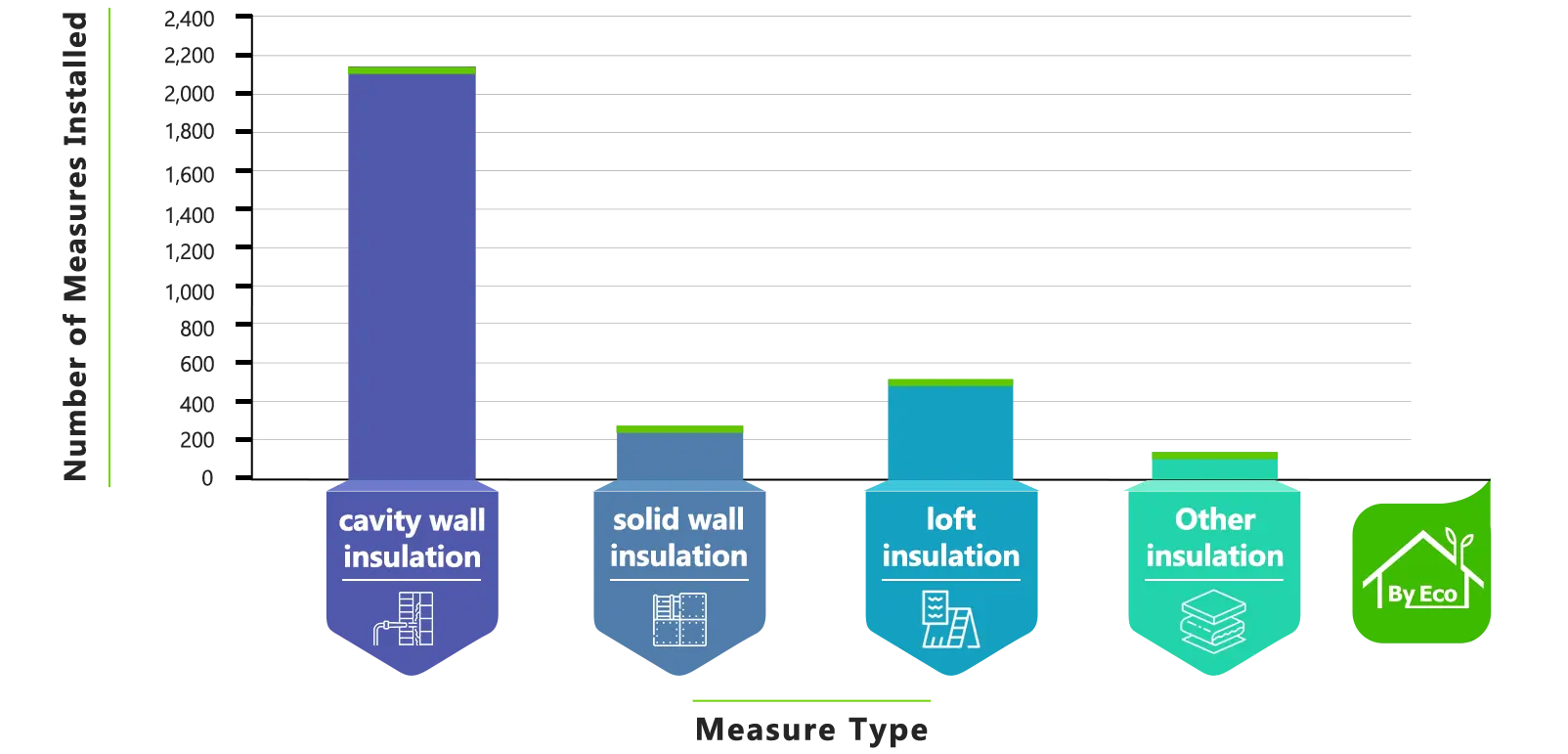
Cavity Wall Insulation: Ideal for homes with cavity walls, this involves injecting insulating materials like mineral wool or polystyrene beads to reduce heat loss. Explore Cavity Wall Insulation to understand how filling the gaps in your walls can dramatically enhance your home's thermal efficiency.
Solid Wall Insulation: For homes without cavity walls, solid wall insulation is critical. By adding a layer externally or internally, it significantly cuts down heat loss, making a substantial difference in energy consumption and living comfort. Learn more about Solid Wall Insulation and its importance for homes lacking cavity walls, offering a significant improvement in your home's warmth and comfort.
Loft Insulation: A cost-effective way to reduce heat loss, loft insulation is essential for preventing warmth from escaping through your roof, ensuring your home stays warm in the colder months and cooler during summer. Discover the benefits of Loft Insulation for effectively retaining heat within your home, a key step towards a snug and energy-efficient living space.
Flat or Pitched Roof Insulation: Tailored solutions for different roof types, ensuring maximum thermal performance for homes with either flat or pitched roofs. Find out how Flat or Pitched Roof Insulation can optimise the thermal performance of your home, regardless of your roof type.

Get your best deal
A Greener Future Starts Here
A Greener Future Starts Here
Underfloor Insulation: Targeting heat loss through floors, underfloor insulation is especially crucial for homes with suspended timber floors, offering a warmer living space and reduced heating costs. See how Underfloor Insulation can transform the comfort levels of your home by targeting heat loss through your floors.
Park Home Insulation: Park homes, especially those built before 2005, often lack sufficient insulation. Our services cover underfloor, external wall, and loft insulation (where applicable) to significantly improve warmth and energy savings. Understand how Park Home Insulation can update your space with modern insulation standards, greatly enhancing warmth and reducing energy consumption.
Solid Floor Insulation: Essential for homes with solid ground floors, this type of insulation adds materials beneath the floor to reduce heat loss, enhancing comfort and leading to lower energy bills. Read about the advantages of Solid Floor Insulation for homes with solid floors, a crucial element for minimising heat loss and maximising comfort.
Room-in-Roof: For homes with converted attics or loft spaces, this insulation minimises heat escape, providing enhanced comfort and energy efficiency. Investigate how Room-in-Roof Insulation can make your converted attic or loft space more energy-efficient and comfortable throughout the year.
Here is a breakdown of the cost and saving expectations for each type of home insulation:
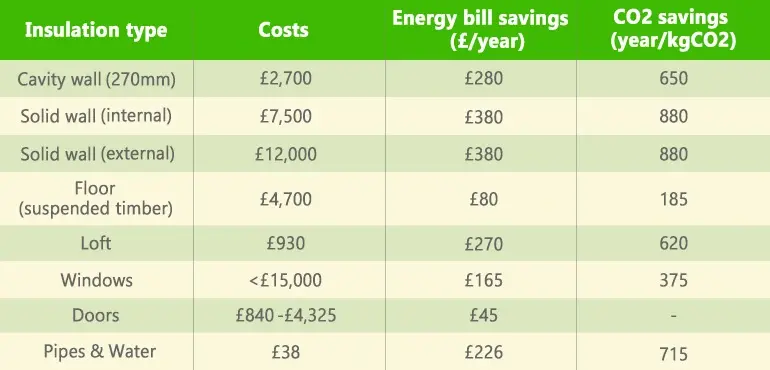
With various options available, including loft, wall, and floor insulation, homeowners can significantly enhance the warmth and comfort of their living spaces while also cutting down on energy costs and reducing carbon footprint.
Our team at ByEco provides tailored recommendations based on a comprehensive assessment of your home, ensuring the chosen insulation type aligns perfectly with your needs.
Best insulation materials
Ultimately, selecting the 'best' insulation material is a matter of personal preference, with the optimal choice depending on your property's characteristics, budget, and specific energy efficiency goals.
Here's a brief overview of the traditionally used insulation materials in UK homes:
Mineral Wool: A versatile and widely used insulation material suitable for lofts, walls, and floors. Composed of natural or recycled materials like stone or slag, mineral wool offers excellent thermal and acoustic insulation properties. Its fire-resistant nature adds an extra layer of safety to your home, making it a reliable and durable choice for various insulation needs.
Sheep's Wool: An eco-friendly and sustainable insulation option harvested from natural wool fibres. Ideal for loft and wall insulation, sheep's wool effectively regulates humidity and provides outstanding thermal performance. Its biodegradable and renewable characteristics make it a popular choice for homeowners seeking environmentally responsible solutions.
Cellulose: Made from recycled paper products, cellulose insulation is an environmentally conscious option that delivers high thermal efficiency. Commonly used in lofts and wall cavities, it is treated with fire-retardant chemicals to enhance safety. Cellulose insulation excels in reducing air infiltration, thereby improving your home's energy efficiency and lowering heating costs.
Expanded Polystyrene (EPS): A lightweight and durable insulation material typically used for external wall and floor insulation. EPS offers impressive moisture resistance and consistent thermal performance, making it suitable for various construction applications. Its ease of installation and cost-effectiveness contribute to its popularity among UK homeowners.
Fiberglass: One of the most common insulation materials, fiberglass is made from fine strands of glass and is typically used in lofts, walls, and roofs. It’s effective in trapping air and slowing down the transfer of heat, making it a reliable choice for maintaining warmth during colder months.
Polystyrene: This material, available in expanded (EPS) and extruded (XPS) forms, is popular for wall and floor insulation. Polystyrene provides excellent thermal resistance and is moisture-resistant, making it suitable for various construction applications.
Polyurethane (PUR): Known for its high insulation value, polyurethane is often applied as a spray foam. It is ideal for filling small gaps and cracks in walls and roofs, providing a seamless barrier against heat loss and enhancing the overall energy efficiency of homes.
PIR Boards: Polyisocyanurate (PIR) boards are rigid insulation panels that offer superior thermal performance. Commonly used in walls, floors, and roofs, PIR boards are valued for their durability, moisture resistance, and fire retardant properties, making them a premium choice for home insulation.
Denim Insulation: Made from recycled cotton and denim fabric, denim insulation is an eco-friendly option that offers excellent thermal and acoustic insulation. It’s free from harmful chemicals, making it safe for both installers and residents. Denim insulation is commonly used in lofts, walls, and floors, providing a sustainable and effective alternative to traditional materials.
Perlite Insulation: Perlite is a natural volcanic glass that expands when heated, creating a lightweight and porous material ideal for insulation. It’s particularly effective in cavity walls due to its moisture resistance and excellent thermal properties. Perlite is also fire-resistant and provides long-lasting insulation, making it a popular choice for enhancing energy efficiency in UK homes.
Benefit from UK Government Schemes
The Great British Insulation Scheme (GBIS)
Starting its activities in April 2023, GBIS aims to deliver cost-effective insulation measures to a broad range of households. Focusing on both broader and low-income groups, the scheme enhances access to insulation, contributing to quicker, more effective energy efficiency improvements across the UK.
The Energy Company Obligation (ECO4)
The Energy Company Obligation (ECO4) scheme, active from April 2022 to March 2026, targets the enhancement of insulation and heating systems in homes across the UK. Focused on supporting low-income, fuel-poor, and vulnerable households, ECO4 facilitates the adoption of energy-saving measures. Providing funding for upgrades like cavity wall, loft, and underfloor insulation, ECO4 is instrumental in reducing energy bills and carbon emissions. It makes homes warmer, more comfortable, and environmentally friendly, representing a critical step towards nationwide energy efficiency and sustainability goals.
Unlocking Free Insulation: Are You Eligible?
Discover your eligibility for free insulation services under ECO4 or GBIS by completing our form. Our partnership with the government ensures that qualifying homes receive the necessary insulation upgrades for free or at a reduced cost, making sustainable living accessible to everyone.
Why Choose ByEco?
ByEco stands at the forefront of renewable energy solutions, offering free insulation services backed by government schemes like GBIS and ECO4. Our commitment is to break down financial barriers, providing you with expert assessments and installations that lead to a greener, more efficient home.
Embarking on Your Sustainable Journey
Start your path to a greener, more energy-efficient home with ByEco. Our free consultation will guide you through the application process for the UK government-backed insulation grants, enhancing your home's comfort and contributing to a sustainable future.
DIY vs. Professional Installation
When it comes to insulating your home, deciding between a do-it-yourself (DIY) project and opting for professional installation is crucial for achieving the best results. While DIY insulation may seem cost-effective initially, it requires a thorough understanding of materials and techniques to avoid common mistakes. Choosing professional installation services from ByEco ensures your insulation is expertly and safely installed, maximising its efficiency and longevity. Our deep expertise guarantees the use of the most suitable insulation for each part of your home, following the highest installation standards.
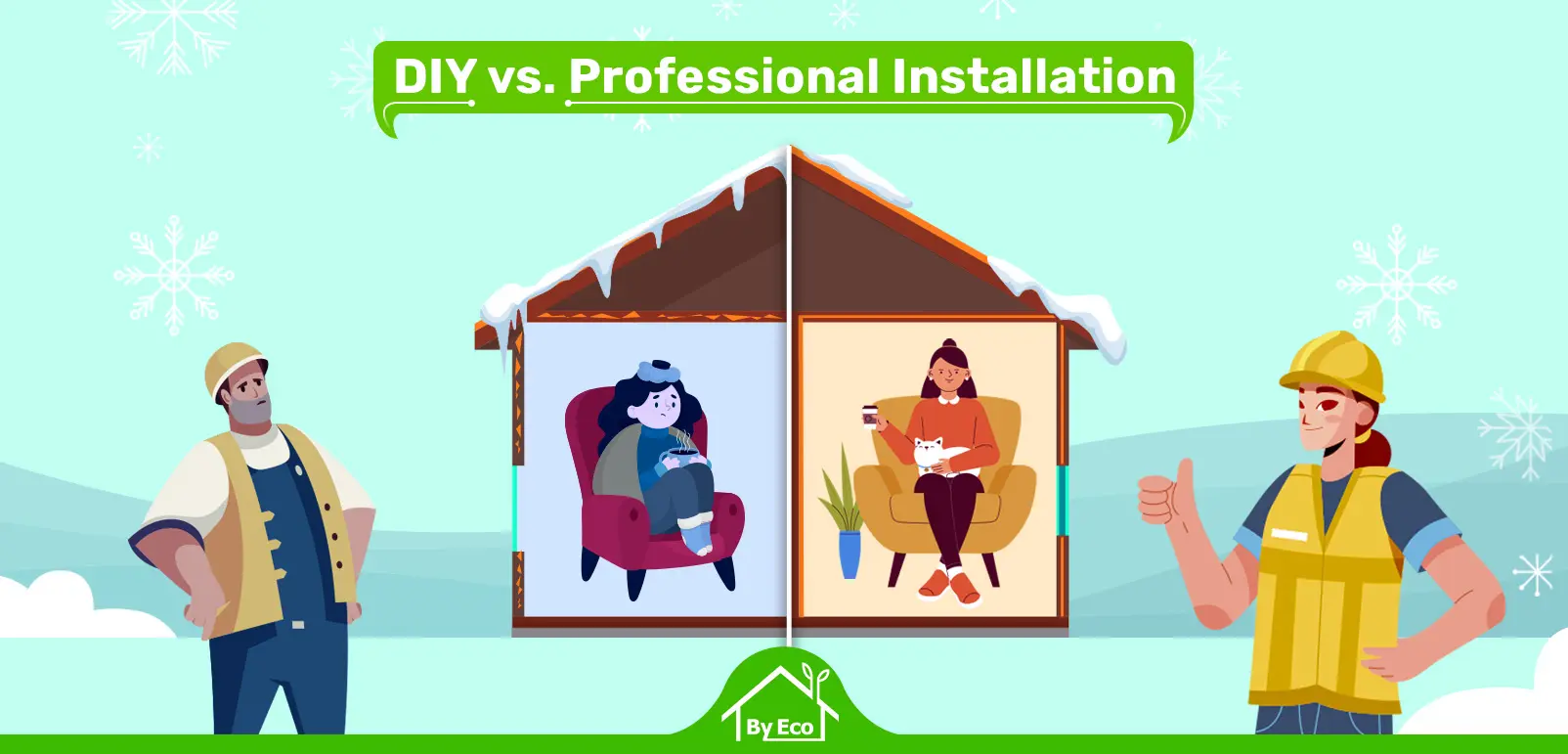
Our expert approach minimises potential risks, enhances your home's energy efficiency, and offers professional guidance, potentially unlocking special offers and government incentives. Opting for ByEco's professional installation ensures you'll enjoy an effortless, hassle-free process, guaranteeing top-notch insulation effectiveness and giving you confidence that your investment is enhancing your home's comfort and reducing energy costs. Start your journey towards sustainability with us, taking advantage of expert advice and support from the outset.
